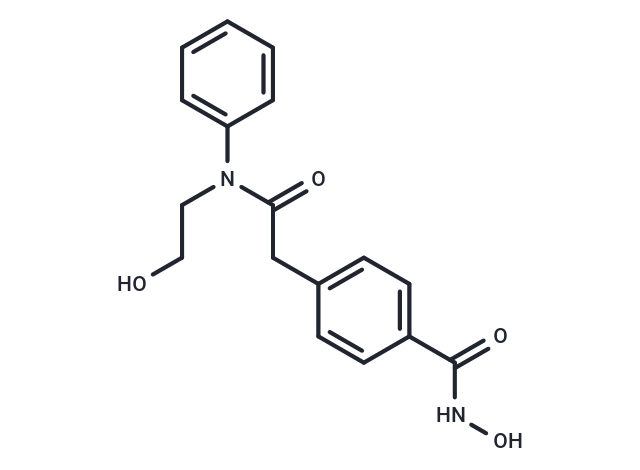Shopping Cart
- Remove All
 Your shopping cart is currently empty
Your shopping cart is currently empty
HPOB is an effective and specific HDAC6 inhibitor (IC50: 56 nM), >30-fold selectivity over other HDACs.

| Pack Size | Price | Availability | Quantity |
|---|---|---|---|
| 5 mg | $50 | In Stock | |
| 10 mg | $72 | In Stock | |
| 1 mL x 10 mM (in DMSO) | $55 | In Stock |
| Description | HPOB is an effective and specific HDAC6 inhibitor (IC50: 56 nM), >30-fold selectivity over other HDACs. |
| Targets&IC50 | HDAC6:56 nM, HDAC1:2.9 μM, HDAC2:4.4 μM, HDAC10:3.0 μM, HDAC3/NCOR2:1.7 μM, HDAC8:2.8 μM |
| In vitro | In mice bearing CWR22 human prostate cancer xenografts, the combination of HPOB (300 mg/kg/day) with SAHA significantly inhibits the growth of pre-existing tumors, whereas the use of either compound alone does not exhibit a noticeable inhibitory effect. |
| In vivo | In HFS cells, HPOB enhances transformation cell death induced by Etoposide, Doxorubicin, or SAHA. HPOB also augments Etoposide-induced transformation cell death in transformed cells via the apoptosis pathway. In both normal (HFS) and transformed (LNCaP, A549, and U87) cells, HPOB induces α-tubulin proteins without affecting histones, inhibiting cell growth without impacting cell viability. |
| Kinase Assay | In Vitro Enzymatic Assay for Histone Deacetylases: In vitro activities of the 11 recombinant human zinc-dependent HDAC enzymes are detected by ?uorigenic release of 7-amino-4-methylcoumarin from substrate upon deacetylase enzymatic activity. A series of dilutions of the unique HDAC6 compound, tubacin, and SAHA are prepared with 10% DMSO in HDAC assay buffer, and 5 μL of the dilution was added to a 50-μL reaction so that the ?nal concentration of DMSO is 1% in all of the reactions. The enzymatic reactions are conducted in duplicate at 37 °C for 30 min in a 50-μL mixture containing HDAC assay buffer, 5 μg BSA, an HDAC substrate, an HDAC enzyme, and a test compound. After enzymatic reactions, 50 μL of 2× HDAC developer is added to each well, and the plate is incubated at room temperature for an additional 15 min. Fluorescence intensity is measured at an excitation of 360 nm and an emission of 460 nm using a Synergy microplate reader. Negative (no enzyme, no inhibitor, a drug with no HDAC inhibition activity) and positive controls (known HDAC inhibitor SAHA) are included in the assays. IC50 is determined at the drug concentration that results in 50% reduction of HDAC activity compared with the control. |
| Cell Research | Normal (HFS) and transformed (LNCaP, A549, and U87) cells are cultured with indicated doses of HPOB for 72 h. Five micromolars SAHA is a positive control.Graphs were constructed using Prism 5. (Only for Reference) |
| Molecular Weight | 314.34 |
| Formula | C17H18N2O4 |
| Cas No. | 1429651-50-2 |
| Smiles | OCCN(C(=O)Cc1ccc(cc1)C(=O)NO)c1ccccc1 |
| Relative Density. | no data available |
| Storage | Powder: -20°C for 3 years | In solvent: -80°C for 1 year | Shipping with blue ice/Shipping at ambient temperature. | |||||||||||||||||||||||||||||||||||
| Solubility Information | Ethanol: 36 mg/mL (114.53 mM), Sonication is recommended. DMSO: 58 mg/mL (184.51 mM), Sonication is recommended. H2O: < 1 mg/mL (insoluble or slightly soluble) | |||||||||||||||||||||||||||||||||||
Solution Preparation Table | ||||||||||||||||||||||||||||||||||||
Ethanol/DMSO
| ||||||||||||||||||||||||||||||||||||

Copyright © 2015-2025 TargetMol Chemicals Inc. All Rights Reserved.